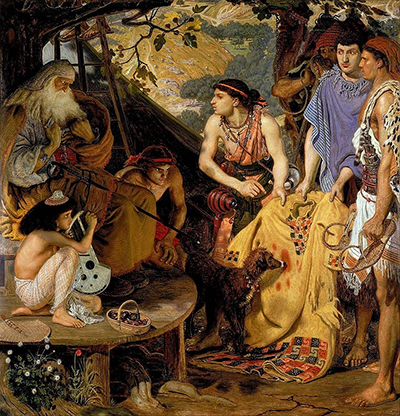This is one of Ford Maddox Brown's finest. It depicts a gathering of young adult men, an old man and a boy collected in a social manner around a beautiful coat. There is a dog in the midst also, close to this coat, the center of this entire art.
Jacob and Joseph's coat is a classic biblical allusion piece of art. It portrays the scene of Joseph’s brothers bringing back his coat and lying to Jacob about Joseph’s death. His brothers were jealous of him because he was Jacobs’s favorite. Jacob gave Joseph the coat as a gift. To his brothers, it was a symbol of leadership, and this, they envied deeply. He was a threat and therefore, was eliminated. The coat is spotted in red spots. A symbol of blood, Joseph's blood indicating his death. And now, it’s only the coat that’s left. The only connection between Jacob and Joseph. A manifestation of love from father to son. The painting captures a sad mood, together with betrayal and deception acts. A sin committed.
Jacob and Joseph’s coat is also referred to as the coat of many colors. The art piece is a romanticism style religious painting illustrating the Old Testament story of Joseph and his brothers. It was created in England by Ford Maddox Brown from 1868 to 1871. Designed from canvas, oil, and watercolor, with a 52.5 by 50 cm dimensions. It displays a moment in biblical times frozen. A time stopped to tell of transgressions of men. The watercolor used for the background landscape was borrowed. It belonged to his friend, Thomas Sodden, which he painted in Palestine. Most of Maddox’s works were on morality and history subjects’.For instance, he spent years of painting the famous 12 works of the Manchester murals that tell the Mancunian history in the town hall of Manchester.
There are dozens of artworks by Maddox, of all his works, there’s one that really made a mark in his life. He tried to illustrate the totality of the mid-Victorian socialism all captured in a single image. This came with financial assistance from Thomas Plint, who did so with the prospect of obtaining the finished piece. Thomas died in 1861 before the piece was completed. This art is a masterpiece that captures the social design of an urban environment in modern times. It is a mastery that pops up a lot of unanswered questions.




